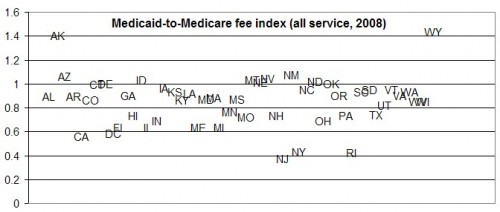Last week, Sarah Kliff reported on a recent NBER study of Medicaid managed care by Mark Duggan and Tamara Hayford. The study found that,
[S]hifting Medicaid recipients from fee-for-service into [Medicaid managed care] did not reduce Medicaid spending in the typical state. However, the effects of the shift varied significantly across states as a function of the generosity of the state’s baseline Medicaid provider reimbursement rates. These results are consistent with recent research on managed care among the privately insured, which finds that HMOs and other forms of managed care achieve their savings largely through reduced prices rather than lower quantities. [Emphasis mine.]
Where state Medicaid payments to providers are relatively more generous, managed care organizations have room to maneuver on price and could produce savings, though the same savings could be produced by lowering state rates. Where Medicaid payments are relatively low, managed care can’t do much. On average, it doesn’t.
It got me wondering, just how much do Medicaid rates vary? To answer this question properly, it is not enough to simply compare them across states. After all, the cost of care varies by state, and one would want to control for that. A good way to pose the question is, how do Medicaid rates vary relative to Medicare’s, which are adjusted for the cost of care?
This question is addressed in a 2009 Health Affairs paper by Stephen Zuckerman, Aimee Williams, and Karen Stockley. Exhibit 3 of the paper reports state Medicaid rates relative to those of Medicare for all services,* primary care, obstetric care, and other services in 2008. Below I’ve graphed just the ratios for all services.
There were, in 2008, eleven states with Medicaid physician payments at least as high as Medicare’s (AK, AZ, DE, ID, MT, NE, NV, NM, ND, OK, WY). All other states had Medicaid rates below those of Medicare in 2008. To be sure, some argue that Medicare rates are (or were) too low as well. But usually we hear about Medicaid rates being even further below Medicare’s. Yes, that’s true overall–Medicaid rates were 72% of Medicare’s in 2008, on average–but it was not the case in eleven states.
* All services include primary care, obstetrical care, hospital visits, surgery, radiology, psychotherapy, and laboratory tests.



